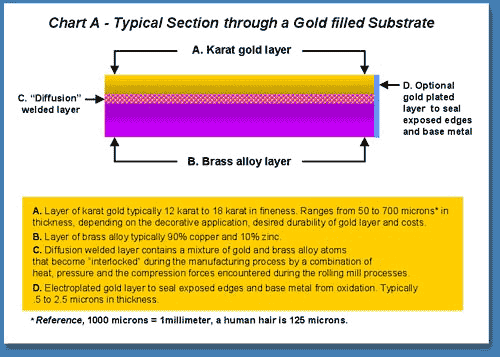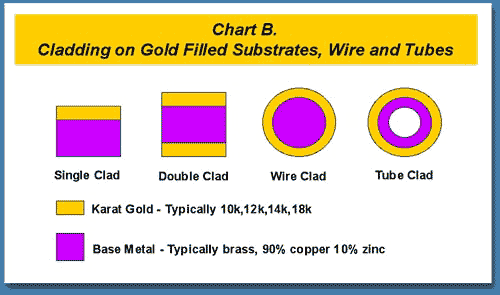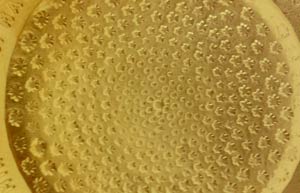The joining of a base metal with an outer layer of gold has played an important commercial role in the jewelry industry and their related trades for over 150 years. Commonly referred to as “gold filled” this process is also known in the industry as “rolled gold”, “gold overlay”, or “metal cladding”. The process for creating gold filled sheet stock, wire and hollow tubing was developed by the industry to help reduce costs for jewelry and houseware items without sacrificing their perceived beauty, durability, and long term wear. Gold filled materials are heavily utilized for watch cases, cigarette cases, mid-priced high fashion jewelry, and numerous other decorative items.
One of the many advantages of gold filled materials is that the gauge of the decorative gold sheet can be adjusted to any thickness, karat purity and color. In addition, important working characteristics such as formability, strength, and rigidity can be easily modified by using a different base metal (i.e. mild steel or bronze) without changing the surface beauty of the object.
The Manufacturing Process
Gold filled products are created utilizing a process that starts with a base metal such as brass (i.e. 90% copper and 10% zinc) or nickel on which a thin sheet of karat gold of the desired thickness has been “welded”. The process begins by carefully fitting the base metal under a gold sheet of the desired karat alloy and thickness.
They are then placed in a air tight steel enclosure that has a carefully controlled atmosphere. The edges of the two metals are covered with a flux type paste to help protect them from oxidation and scaling. Within a gas fired furnace, the base metal and gold sheet are rapidly heated to a suitable welding temperature of about 900 degrees centigrade.
It is then removed and is immediately “pressed” in a hydraulic press at about 2500 psi. The attachment weld between the gold and base metal substrate is achieved by “alloy diffusion” (see chart a). This occurs because the atoms on the outer surface of each metal substrate collide and combine with each other to form a strong “alloy based” metallurgical bond.

The process continues by rolling the welded composite of gold and base metal in a rolling mill. Combined with annealing (a heat treat process that softens the metal for the rolling mill process) the welded bond between the gold layer and base metal is further enhanced by alloy diffusion that occurs from additional compression from the rolling mill process. The resulting weld is so strong that the finished gold filled sheet stock can be formed, fabricated and soldered without any risk of delamination.
Once the gold filled sheet is welded, additional finishing operations are needed. The sheet stock is “finished rolled” to the precise commercial gauge. Additionally, the surfaces are cleaned and all edges are trimmed to the desired widths and inspected prior to final shipment to the manufacturer.
Types of Cladding for Gold-Filled Products
The placement of the gold sheet layer onto the base metal is also referred to as “cladding” (see chart b). Single clad gold filled products has a gold sheet welded to the side of the base metal which is intended to be the decorative side or “show surface”. Double cladding as its name implies has a sheet layer of gold welded to both sides of the base metal.
Typically, double-clad gold-filled sheet stocks are used on items to prevent any discoloring or to enhance its value (e.g. cigarette case). Since the edges of the gold filled sheet stock are sometimes exposed, supplementary gold plating is often necessary to “seal” the base metal core to prevent any chance of corrosion or discoloration.
Round gold filled wire and hollow tube stock have a layer of welded gold fused completely around a core of base metal. This type of gold filled stock can be used in the fabrication of eye wear.

Commercial Thickness for Gold-Filled Objects
In practice, most gold filled products utilize an outer layer of gold that is between 10 karat and 18 karat in fineness. Depending on the usage, the thickness of the gold sheet varies. High wear items such as watch cases and cigarette lighters typically utilize a thickness ranging from 75 to 400 microns (ref. 1000 microns= 1 millimeter).
Eye glass frames utilize gold filled thicknesses between 15 to 30 microns. Thicknesses for high fashion jewelry, such as cuff link, bracelets, and money clips will range from 30 to 100 microns.
As thin as this may seem, the decorative show surface on many well executed gold filled items can last anywhere from 20 to 30 years! It is not unusual to observe reasonably intact gold filled surfaces on watches and vintage jewelry manufactured well over 75 years ago.
Commercial Designations and Markings
All items designated and sold commercially as “gold filled” or “rolled gold” must comply with the trade rules set forth by the Federal Trade Commission (FTC). The total gold content for an object designated gold filled must equal 1/20th of the total weight of the finished item.
As an example, a bracelet marked as “1/20 14k GF” with a total weight of 60 grams (2oz.) would mean that there should be at least 3 grams of 14 karat gold (60 grams divided by 20) utilized in the outer clad layers of the finished item. The remaining 57 grams could be comprised of a non-gold base metal material, hinge hardware and solder used in the fabrication of the piece.
Items designated as “rolled gold” share essentially the same manufacturing processes as gold filled items except that the quantity of karat gold used in the cladding is less than 1/20th of the total weight of the finished item.
A typical legal marking might then appear as 1/40 12k R.G.P. This designation would mean that a 12 karat cladding comprises 1/40th of the total weight of the rolled gold piece. Items that are rolled gold by designation generally cost less or are used on items where durability from rough handling and wear is not the prime consideration.
Thickness Comparison of Gold-Filled and Gold Electroplated Finishes
Gold filled (chart c-1) substrates are commonly used for metal designs that have simple shapes and planar surface contours (i.e. cigarette lighters, eye glass frames). Gold filled designs have the advantage of providing excellent long term wear durability of solid alloy gold products without the weight and higher costs.
In most cases, a gold filled item can be repaired if damaged or badly scratched. Unlike gold electroplated products, the thicker cladding used on gold filled items can also be carefully repolished several times without the exposing the underlying base metal.
"Gold Filled" Finishes
| chart c - 1 | |||
|---|---|---|---|
| Item category | Layer thickness | Estimated durability in years * |
|
| microns | micro-inches | ||
| belt buckle | 40–70 | 1,574–2,952 | 5–10 |
| bracelet | 30–75 | 1,181–2,962 | 5–10 |
| chains | 5–10 | 196–393 | 2–8 |
| cufflinks | 20–40 | 787–1,574 | 5–8 |
| eye frames | 10–20 | 393–787 | 5–8 |
| pens | 20–40 | 787–1,574 | 5–15 |
| wire stock | 15–45 | 590–1,771 | 7–10 |
| watches | 50–120 | 1,968–4,724 | 10–35 |
| * durability estimates provided by Metal Arts Specialties, based on normal and reasonable wear parameters | |||
Gold electroplated finishes (chart c-2) are used when designs are complex in shape, intricate, or very large in size. Gold plating has the advantage of providing good wear durability and is far less expensive than gold filled products. Newer and harder gold plating formulas being pioneered by the electronics industry will soon match gold filled products for durability.
Gold plated items are not easily repaired or repolished. Often replating will need to be done if the repaired item has to be welded or soldered. However, gold plating can be used over gold filled items to conceal repairs or to impart a uniformity to a surface or texture.
"Gold Electroplated" Finishes
| chart c-2 | |||
|---|---|---|---|
| Item category | Layer thickness | Estimated durability in years * |
|
| microns | micro-inches | ||
| belt buckle | 2.5–8.0 | 98–314 | 2–5 |
| bracelet | 2.5–8.0 | 98–314 | 3–7 |
| chains | 0.5–2.5 | 19–98 | 1–3 |
| cufflinks | 2.5–5.0 | 98–196 | 2–5 |
| eye frames | 1.0–2.5 | 39–98 | 1–3 |
| pens | 2.5–5.0 | 98–196 | 2–7 |
| wire stock | — | — | — |
| watches | 5.0–20.0 | 196–787 | 10–35 |
| * durability estimates provided by Metal Arts Specialties, based on normal and reasonable wear parameters | |||
Reference for Microns and Microinches
[row][one_half]
| Comparison Reference for Microns |
|---|
| 1000 microns = 1 millimeter, 1 micron = 39.37 microinches, 125 microns or .125 millimeters = thickness of 1 human hair follicle |
| Comparison Reference for Microinches |
|---|
| 1 microinch = 1 one millionth of an inch, 39.37 microinches = 1 micron, 4921 microinches or 4.92 mils = thickness of 1 human hair follicle |
[fblock title=”For additional Information…” icon=” fa-book fa-fw”]For additional information regarding electroplating and metal refinishing, be sure to visit our faqs section located on this site. If we can assist you in your custom plating and metal refinishing needs, please contact us.[/fblock]
[row][one_half]
Metal Arts Specialties
[contact tel=”+1 (248) 821-3450″ email=”[email protected]” /]
8AM–6PM EST


